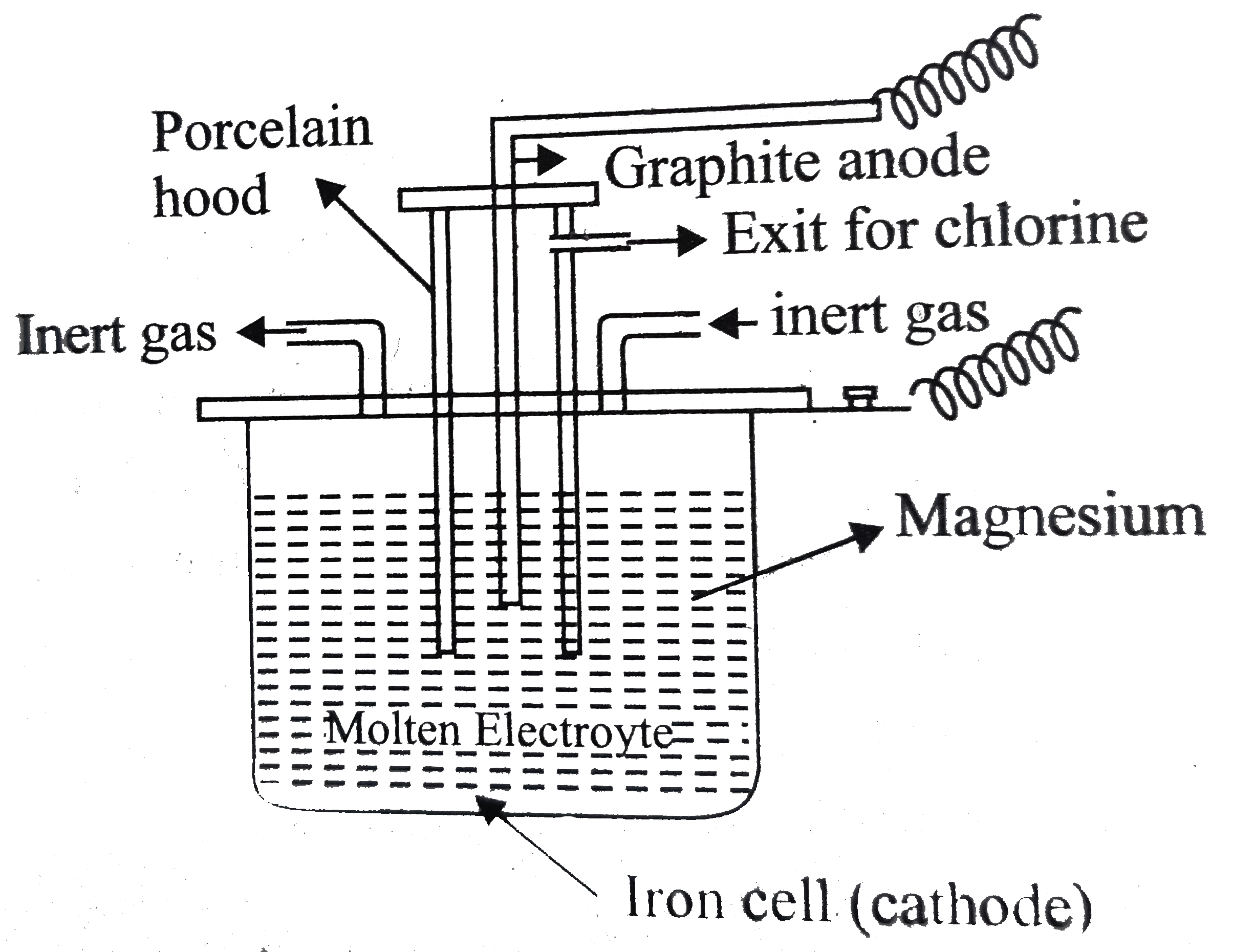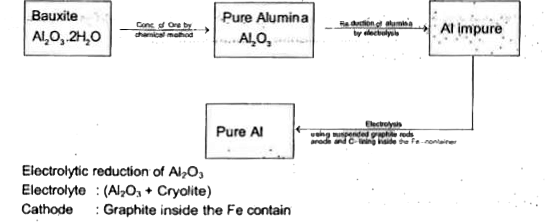For extraction of sodium from NaC1, the electrolytic mixture Nac1+Na3A1F6+Cac12 is used. During extractions process, only sodium is deposited in cathpode but K and Ca do not because
Na is more reactive than K and Ca
Nais less reactive than Kand Ca
NaC1 is less stable than Na3A1F6 and CaC12
the discharge potential of Na+ is less than that of K+ and ca2+ ions.
The correct Answer is:D
Step by step video, text & image solution for For extraction of sodium from NaC1, the electrolytic mixture Nac1+Na_(3)A1F_(6) +Cac1_(2) is used. During extractions process, only sodium is deposited in cathpode but K and Ca do not because by Chemistry experts to help you in doubts & scoring excellent marks in Class 12 exams.
Related Playlists
- BOOK - A2ZCHAPTER - GENERAL PRINCIPLES AND PROCESS OF ISOLATION OF METALSEXERCISE - Section B - Assertion Reasoning17videos
GENERAL PRINCIPLES AND PROCESS OF ISOLATION OF METALS
- BOOK - A2ZCHAPTER - GENERAL PRINCIPLES AND PROCESS OF ISOLATION OF METALSEXERCISE - AIPMT/NEET Questions13videos
GENERAL PRINCIPLES AND PROCESS OF ISOLATION OF METALS
- BOOK - A2ZCHAPTER - GENERAL PRINCIPLES AND PROCESS OF ISOLATION OF METALSEXERCISE - Section D - Chapter End Test30videos
GENERAL PRINCIPLES AND PROCESS OF ISOLATION OF METALS
- BOOK - A2ZCHAPTER - ELECTROCHEMISTRYEXERCISE - Section D - Chapter End Test30videos
ELECTROCHEMISTRY
- BOOK - A2ZCHAPTER - MOCK TESTEXERCISE - Mock Test 245videos
MOCK TEST
Knowledge Check
- Question 1 - Select One
For extraction of sodium from NaCI, the electrolytic mixture NaCI+Na3AIF6+CaCI2 is used. During extraction process, only sodium is deposited on cathode but K and Ca do not because
ANa is more reactive than K and CaBNa is less reative then K and CaCNaCI is less stable than Na3AIF6 and CaCI2Dthe discharge potential of Na+ is less than that of K+ and Ca2+ ions - Question 1 - Select One
For extraction of sodium from NaCl, the electrolytic mixture NaCl+KCl+CaCl2 is used. During extraction process, only sodium is deposited on cathode but K and Ca do not because :
ANa is more reactive than K and CaBNa is less reactive than K and CaCNaCl is less stable than Na3AlF6 and CaCl2Dthe discharge potential of Na+ is more than that of K+ and Ca2+ ions. - Question 1 - Select One
During extraction of metals, electrolytic refining is used to obtain pure metals. During the process, the impure metal is made the anode and a thin strip of pure metal is made the cathode. The solution of the metal salt is used as an electrolyte. On passing the current through the electrolyte, the pure metal from the anode dissolves from the electrolyte. An equivalent of pure metal from the electrolyte is deposited on the cathode.
Which of the metals are refined by electrolytic refining?
I. Au
II. Cu
III. Na
IV. KAI and IIBI and IIICII and IIIDII and IV - Question 1 - Select One
Magnesium is extracted electrolysing fused magnesium chloride containing NaC1and CaC12using:
Aa nickel cathode and a graphite anode.Bthe iron container as anode and a nickel cathode.Cthe iron container as cathode and a graphite rod as anode.Dthe nickel container as cathode and iron as anode.

- Question 1 - Select One
Read the following and answer any four questions
During extraction of metals, electrolytic refining is used to obtain pure metals. During the process, the impure metal is made the anode and a thin strip of pure metal is made the cathode. The solution of the metal salt is used as an electrolyte. On passing the current through the electrolyte, the pure metal from the anode dissolves from the electrolyte. An equivalent of pure metal from the electrolyte is deposited on the cathode.
Which of the metals are refined by electrolytic refining?
(i) Au (ii) Cu
(iii) Na (iv) KA(i) and (ii)B(i) and (iii)C(ii) and (iii)D(ii) and (iv) - Question 1 - Select One
Extraction of aluminum can be understood by

The molten electrolytes contains Na+,AI3+,Ca2+ but only AI gets deposited at cathode because :AStandard reduction potential of AI is more than those of Na & CaBStandard oxidation potential of AI is more than those of Na & CaCDisharge potential AI3+ is higher than Na+&Ca2+DGraphite reacts only with AI3+ and not with Na+&Ca2+ - Question 1 - Select One
If the solubility of lithium sodium hexafluorido aluminate, Li3Na3(AIF6)2 is 's' " mol lt"^(-1) , its solubility product is equal to :
A729s8B12s8C3900s8D2916s8
Similar Questions
In a 40 litres mixture acetic acid and sodium acetate are in the ratio 3:1,find the amount of sodium acetate solution to be added to make the ratio 2:3.
View SolutionThe density of 3 M solution of sodium thiosulphate (Na2S2O3) is 1.25 g/mL. Calculate
amount of sodium thiosulphateView SolutionThe density of 3 M solution of sodium thiosulphate (Na2S2O3) is 1.25 g/mL. Calculate
mole fraction of sodium thiosulphateView Solution

